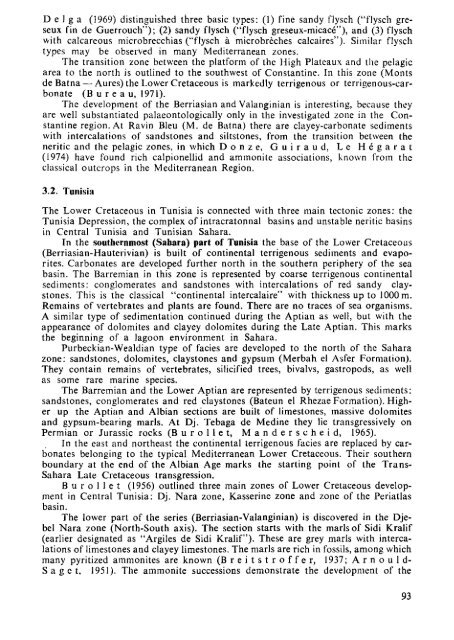THE MEDITERRANEAN LOWER CRETACEOUS
THE MEDITERRANEAN LOWER CRETACEOUS
THE MEDITERRANEAN LOWER CRETACEOUS
Create successful ePaper yourself
Turn your PDF publications into a flip-book with our unique Google optimized e-Paper software.
Delga (1969) distinguished three basic types: (1) fine sandy flysch ("flysch gréseux<br />
fin de Guerrouch"); (2) sandy flysch ("flysch greseux-micacé"), and (3) flysch<br />
with calcareous microbrecchias ("flysch à microbrèches calcaires"). Similar flysch<br />
types may be observed in many Mediterranean zones.<br />
The transition zone between the platform of the High Plateaux and the pelagic<br />
area to the north is outlined to the southwest of Constantine. In this zone (Monts<br />
de Batna — Aures) the Lower Cretaceous is markedly terrigenous or terrigenous-carbonate<br />
(Bureau, 1971).<br />
The development of the Berriasian and Valanginian is interesting, because they<br />
are well substantiated palaeontologically only in the investigated zone in the Constantine<br />
region. At Ravin Bleu (M. de Batna) there are clayey-carbonate sediments<br />
with intercalations of sandstones and siltstones, from the transition between the<br />
neritic and the pelagic zones, in which Donze, Guiraud, Le Hégarat<br />
(1974) have found rich calpionellid and ammonite associations, known from the<br />
classical outcrops in the Mediterranean Region.<br />
3.2. Tunisia<br />
The Lower Cretaceous in Tunisia is connected with three main tectonic zones: the<br />
Tunisia Depression, the complex of intracratonnal basins and unstable neritic basins<br />
in Central Tunisia and Tunisian Sahara.<br />
In the southernmost (Sahara) part of Tunisia the base of the Lower Cretaceous<br />
(Berriasian-Hauterivian) is built of continental terrigenous sediments and evaporites.<br />
Carbonates are developed further north in the southern periphery of the sea<br />
basin. The Barremian in this zone is represented by coarse terrigenous continental<br />
sediments: conglomerates and sandstones with intercalations of red sandy claystones.<br />
This is the classical "continental intercalaire" with thickness up to 1000 m.<br />
Remains of vertebrates and plants are found. There are no traces of sea organisms.<br />
A similar type of sedimentation continued during the Aptian as well, but with the<br />
appearance of dolomites and clayey dolomites during the Late Aptian. This marks<br />
the beginning of a lagoon environment in Sahara.<br />
Purbeckian-Wealdian type of facies are developed to the north of the Sahara<br />
zone: sandstones, dolomites, claystones and gypsum (Merbah el Asfer Formation).<br />
They contain remains of vertebrates, silicified trees, bivalvs, gastropods, as well<br />
as some rare marine species.<br />
The Barremian and the Lower Aptian are represented by terrigenous sediments:<br />
sandstones, conglomerates and red claystones (Bateun el Rhezae Formation). Higher<br />
up the Aptian and Albian sections are built of limestones, massive dolomites<br />
and gypsum-bearing marls. At Dj. Tebaga de Medine they lie transgressively on<br />
Permian or Jurassic rocks (Burollet, Manderscheid, 1965).<br />
In the east and northeast the continental terrigenous facies are replaced by carbonates<br />
belonging to the typical Mediterranean Lower Cretaceous. Their southern<br />
boundary at the end of the Albian Age marks the starting point of the Trans-<br />
Sahara Late Cretaceous transgression.<br />
Burollet (1956) outlined three main zones of Lower Cretaceous development<br />
in Central Tunisia: Dj. Nara zone, Kasserine zone and zone of the Periatlas<br />
basin.<br />
The lower part of the series (Berriasian-Valanginian) is discovered in the Djebel<br />
Nara zone (North-South axis). The section starts with the marls of Sidi Kralif<br />
(earlier designated as "Argiles de Sidi Kralif"). These are grey marls with intercalations<br />
of limestones and clayey limestones. The marls are rich in fossils, among which<br />
many pyritized ammonites are known (Breitstroffer, 1937; A r n о u 1 d-<br />
S a g с t, 1951). The ammonite successions demonstrate the development of the<br />
93

















